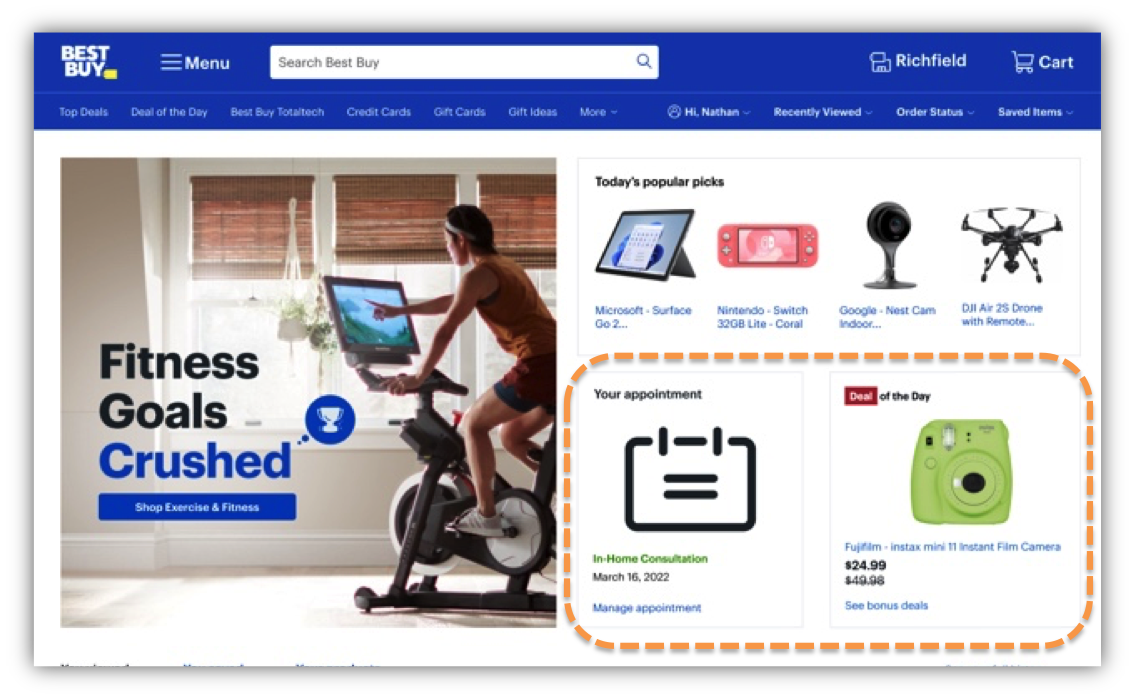Research Context
Like many companies, Best Buy undertook a large initiative to increase performance on their website. As part of this process, certain functionalities were streamlined. Specifically, a concept was developed called ‘Next Best Action’, which placed 2 modules at the top of the Home Page. One intended to Engage the customer with personalized content (such as upcoming appointments), and one intended to Inform the customer of relevant information (deals on previously viewed products). After initially deploying the MVP, I was asked to step in and help evaluate progress on the second iteration, known as Next Best Action 2.0 (NBA 2.0), along with give a more comprehensive look at the home page and it’s content.
Problem Statement & Goal
Problem Statement:
As part of ongoing efforts to improve the customer experience and performance of the Home page, we must further understand the purpuose of the home page from the customers’ perspective. Further examination of customer expectations regarding the presence of specific information is needed, along with the usefulness and desirability of the Next Best Action (NBA) concept.
Goals:
Further understand the role of the Home Page and user expectations of content available to them for discovery intent.
explore user expectations of the amount and type of information avaiable to them in NBA 2.0.
Investigate what ‘item data’ (title, price, reviews, ratings) are key signals for customers during their discovery journey.
Research Methods & Tools
1) Survey
dScout
Quantitative and qualitative metrics
2) interview
dScout
Modified Triptech approach
Team Structure
Sr. Manager, UX Design
Senior UX Designer (x2)
UX Designer
Lead UX Researcher (My role)
Sr. Manager, UX Research
Senior Product Manager
Product Manager
Execution
SURVEY
A survey was conducted of 167 frequent Best Buy customers.
Quantitative measurements were taken in order to gain a better idea of customer preference for home page content.
INTERVIEWS
8 Best Buy customers that have shopped online at Best Buy within the previous month.
60 minute interviews
Expanding off of the survey results, I took the opportunity to dig into the ‘why’ and gain context behind some of the quantitative data collected in the survey.
Triptech questioning was used near the end of the interviews. See below for more on that!
Modified Triptech approach
In the first round of testing for NBA 2.0, the researcher leveraged a heavily modified version of the Triptech approach. This was done in order to gain quantitative metrics to be used as a benchmark for the NBA concept. The approach focused on the 2 individual measurements:
Perceived Usefulness
Desirability
Participants were given an opportunity to interact with the NBA concept and were then asked to give examples of:
use cases where the concept would be useful to them.
use cases where they would want to use the concept.
Results
Below you will find a sample of the results deck. Note: These are a select individual slides and not meant to be represented as the complete results or final deliverable.





Retrospective
triptech approach
This methodology was chosen in order to remain consistent with the first round of research completed by a different researcher. One point of improvement I would make to this study is to choose a different method to measure perceived usefulness. The Triptech approach quantifies perceived usefulness based on the amount of use cases the participant can think of. However, I believe this neglects to account for the fact that a single use case can hold more value to some individuals than 2-3 separate use cases.


